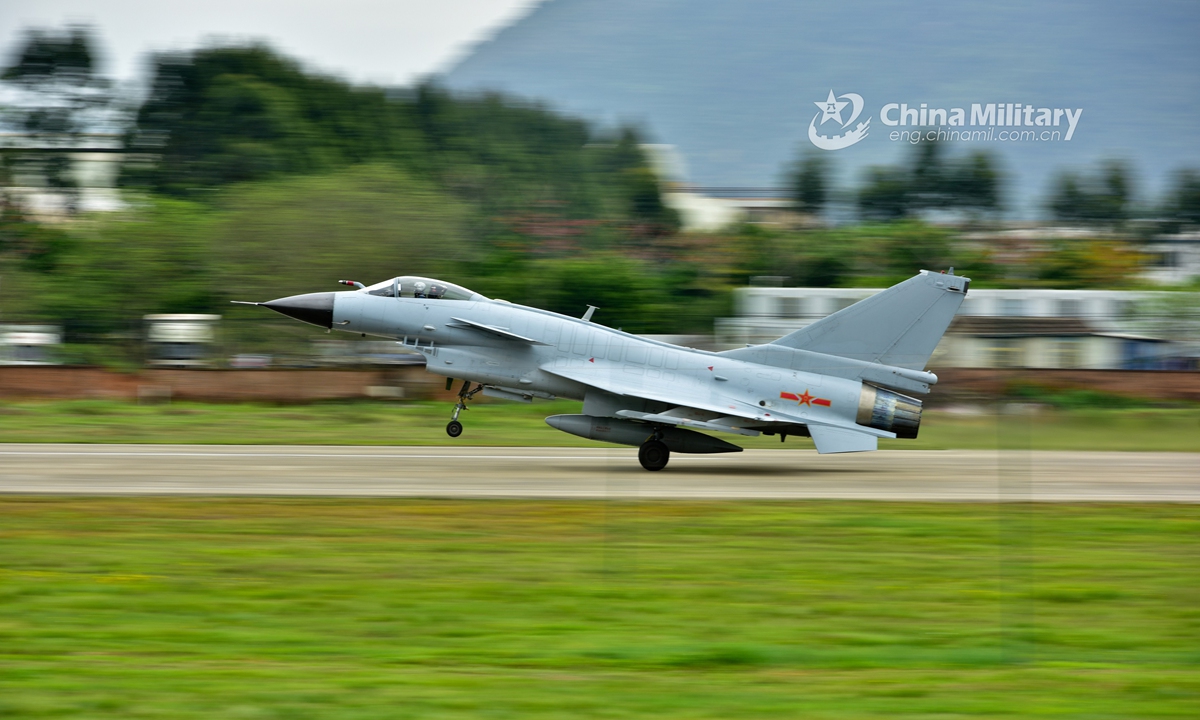PLA fighter jets cross ‘middle line’ of Taiwan Straits an hour before US official’s meeting with Tsai Ing-wen
By Liu Xuanzun Source: Global Times Published: 2020/8/10 18:36:11
Island’s air defense missile deployment provocative, but useless: mainland experts

A J-10 fighter jet attached to an aviation brigade of the air force under the PLA Southern Theater Command takes off for an air combat training sortie on May 23, 2020. (eng.chinamil.com.cn/Photo by Wei Jinxin)
Fighter jets from Chinese People's Liberation Army (PLA) Air Force reportedly crossed the "middle line" of the Taiwan Straits at around 9 am Monday morning, an hour before top US health official met with Taiwan regional leader Tsai Ing-wen.
The PLA operation is considered a strong response to the US move, which broke a diplomatic bottom line of China-US relations. Military operations of even larger scale, like live-fire missile drills east of Taiwan island and near Guam, should not be ruled out if the US provokes further, mainland military experts said on Monday.
For the first time, Taiwan announced the deployment of ground-based air defense missiles to monitor the PLA aircraft, Taiwan media reported. Mainland experts said the deployment was provocative in nature but poses little actual threat.
J-11 and J-10 fighter jets attached to the PLA Air Force briefly crossed the "middle line" of the Taiwan Straits on Monday morning, Taiwan media reported, citing the island's air force headquarters.
The reported PLA operation came on the day as Alex Azar, the US Health and Human Services Secretary, met with Taiwan regional leader Tsai Ing-wen, which is the highest-level meeting between the US and the island in decades, CNN reported.
Xu Guangyu, a senior adviser to the China Arms Control and Disarmament Association, told the Global Times on Monday that Azar's Taiwan visit broke the bottom line and should be considered a serious provocation, and the US is attempting to sound out the mainland's reaction. If the mainland's reponse is weak, it will continue to provoke even further.
The PLA warplanes' operation can give the US and Taiwan secessionists a warning, which showed that the Chinese mainland will not swallow such insults and let them do whatever they want, Xu said.
Xu noted that the PLA operation is a very rational one, and more responses in other fields like diplomacy should follow. If the US goes further, the PLA could take more countermeasures, including live-fire missile drills east of Taiwan island and near Guam.
The mainland is putting efforts to realize a peaceful reunification on the Taiwan question, but it has never ruled out the possibility of reunifying the island by force, and defending against any possible foreign intervention, analysts said.
The military on the island of Taiwan also claimed it used a ground-based air defense missile system to monitor the PLA warplanes' movement. Taiwan media said this is the first time the Taiwan military has announced this kind of deployment.
Beijing-based air defense expert Fu Qianshao told the Global Times on Monday that a ground-based air defense missile system also uses multiple radars, including search, track and fire control radars to detect targets. Previously, Taiwan likely used normal radars for detection, but this time it used a missile system, which is a confrontational escalation and a provocation.
Using stand-alone radar to monitor aircraft is like using binoculars, but using an air defense missile system to monitor aircraft is like pointing a sniper rifle that can fire at any time, observers said.
However, this threatening move is of little practical use against the PLA. When exposed to fire control radars, PLA aircraft can commence jamming, evasive maneuvers, anti-radiation strikes and electronic suppression, Fu said, noting that should there be actual war in the region, most Taiwan anti-aircraft installations will be destroyed in the first place.